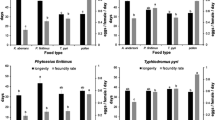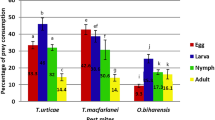Abstract
The predation rate of fifth instars and female adults of Orius laevigatus (Fieber) fed honeybee pollen, Ephestia kuehniella Zeller eggs or an egg yolk based artificial diet on second instars of the western flower thrips Frankliniella occidentalis (Pergande) was examined in the laboratory. Predation rate of both fifth instars and female adults was not influenced by their diet. Despite a lower body weight, O. laevigatus reared on artificial diet or pollen killed as many prey as their peers reared on E. kuehniella eggs, suggesting that body weight is not a reliable predictor of predation rate. The use of non-prey foods for O. laevigatus for mass production or as a supplementary food to sustain its populations in the field when prey are scarce is discussed.
Similar content being viewed by others
References
Arijs Y, De Clercq P (2001) Rearing Orius laevigatus on cysts of the brine shrimp Artemia franciscana. Biol Control 21:79–83
Arijs Y, De Clercq P (2002) Artificial diets for the production of natural enemies (predators and parasitoids) of greenhouse pest insects. Final consolidated report, FAIR-project no. CT-98 4322
Bonte M, De Clercq P (2008) Developmental and reproductive fitness of Orius laevigatus (Hemiptera: Anthocoridae) reared on factitious and artificial diets. J Econ Entomol 101:1127–1133
Bonte M, De Clercq P (2010) Impact of artificial rearing systems on the developmental and reproductive fitness of the predatory bug, Orius laevigatus. J Insect Sci (in press)
Brødsgaard HF (1989) Frankliniella occidentalis (Thysanoptera: Thripidae) a new pest in Danish glasshouses. A review. Dan J Plant Soil Sci 93:83–91
Castañé C, Iriarte J, Lucas E (2002) Comparison of prey consumption by Dicyphus tamaninii reared conventionally, and on a meat-based diet. BioControl 47:657–666
Chocorosqui VR, De Clercq P (1999) Developmental and predatory performance of Podisus maculiventris (Say) (Heteroptera: Pentatomidae) reared on a meat-based artificial diet. Med Fac Landbouww Univ Gent 64:229–234
Cocuzza GE, De Clercq P, Van de Veire M, De Cock A, Degheele D, Vacante V (1997) Reproduction of Orius laevigatus and Orius albidipennis on pollen and Ephestia kuehniella eggs. Entomol Exp Appl 82:101–104
Cohen AC, Smith LK (1998) A new concept in artificial diets for Chrysoperla rufilabris: the efficacy of solid diets. Biol Control 13:49–54
Coll M (1996) Feeding and ovipositing on plants by an omnivorous insect predator. Oecologia 105:214–220
De Clercq P, Degheele D (1993) Quality assessment of the predatory bugs Podisus maculiventris (Say) and Podisus sagitta (Fab.) (Heteroptera: Pentatomidae) after prolonged rearing on a meat-based artificial diet. Biocontrol Sci Technol 3:133–139
EPPO (2009) European and Mediterranean Plant Protection Organization. http://archives.eppo.org/EPPOStandards/biocontrol_web/heteroptera.htm
Grenier S, De Clercq P (2003) Comparison of artificially vs. naturally reared natural enemies and their potential for use in biological control. In: van Lenteren JC (ed) Quality control and the production of biological control agents: theory and testing procedures. CAB International, Cambridge, USA, pp 115–131
Hagler JR, Cohen AC (1991) Prey selection by in vitro and field-reared Geocoris punctipes. Entomol Exp Appl 59:201–205
Hoogerbrugge H, van Houten Y, van Baal E, Bolckmans K (2008) Alternative food sources to enable establishment of Amblyseius swirskii (Athias-Henriot) on chrysanthemum without pest presence. IOBC/WPRS Bull 32:79–82
Jensen SE (2000) Insecticide resistance in the western flower thrips, Frankliniella occidentalis. Integr Pest Manag Rev 2:131–146
Leon-Beck M, Coll M (2007) Plant and prey consumption cause a similar reductions in cannibalism by an omnivorous bug. J Insect Behav 20:67–76
Montserrat M, Albajes R, Castañé C (2000) Functional response of four heteropteran predators preying on greenhouse whitefly (Homoptera: Aleyrodidae) and western flower thrips (Thysanoptera: Thripidae). Environ Entomol 29:1075–1082
Riudavets J, Castañé C (1998) Identification and evaluation of native predators of Frankliniella occidentalis (Thysanoptera: Thripidae) in the Mediterranean. Environ Entomol 27:86–93
Saavedra JLD, Zanuncio JC, Zanuncio TV, Guedes RNC (1997) Prey capture ability of Podisus nigrispinus (Dallas) (Het. Pentatomidae) reared for successive generations on a meridic diet. J Appl Entomol 121:327–330
Skirvin DJ, Kravar-Garde L, Reynolds K, Jones J, Mead A, Fenlon J (2007) Supplemental food affects thrips predation and movement of Orius laevigatus (Hemiptera: Anthocoridae) and Neoseiulus persimilis (Acari: Phytoseiidae). B Entomol Res 97:309–315
SPSS Inc (2006) Guide to data analysis, version 15.0. SPSS Inc
Thompson SN, Hagen KS (1999) Nutrition of entomophagous insects and other arthropods. In: Bellows TS, Fisher TW (eds) Handbook of biological control: principles and applications. Academic Press, San Diego, California, pp 594–652
Tommasini MG, Maini S (1995) Frankliniella occidentalis and other thrips harmful to vegetable and ornamental crops in Europe. Wageningen Agric Univ Pap 95:1–42
Vacante V, Cocuzza GE, De Clercq P, Van de Veire M, Tirry L (1997) Development and survival of Orius albidipennis and O. laevigatus (Het.: Anthocoridae) on various diets. Entomophaga 42:493–498
van der Blom J, Robledo A, Torres S, Sánchez JA (2009) Consequences of the wide scale implementation of biological control in greenhouse horticulture in Almeria, Spain. IOBC/WPRS Bull 49:9–13
van Lenteren J (2003) Need for quality control of mass-produced biological control agents. In: van Lenteren JC (ed) Quality control and the production of biological control agents: theory and testing procedures. CAB International, Cambridge, USA, pp 1–18
Wade MR, Zalucki MP, Wratten SD, Robinson KA (2008) Conservation biological control of arthropods using artificial food sprays: Current status and future challenges. Biol Control 45:185–199
Acknowledgements
We thank A. Janssen and two anonymous reviewers for their helpful comments on this article. This study was supported by project no. B/06836/01 from BOF-UGent.
Author information
Authors and Affiliations
Corresponding author
Additional information
Handling Editor: Arne Janssen.
Rights and permissions
About this article
Cite this article
Bonte, M., De Clercq, P. Influence of diet on the predation rate of Orius laevigatus on Frankliniella occidentalis . BioControl 55, 625–629 (2010). https://doi.org/10.1007/s10526-010-9275-0
Received:
Accepted:
Published:
Issue Date:
DOI: https://doi.org/10.1007/s10526-010-9275-0




